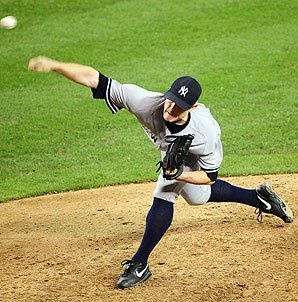Pitching Mechanics Myths: Chin to Target, Release Ball Closer to the Plate

While I’m working on my book – Hacking The Kinetic Chain – there are a few blog posts I feel like I need to make because of myths that are constantly perpetuated about pitching mechanics that are pretty ridiculous and also easily disproved. Since I sublease space from North Seattle Batting Cages and the high school and Little League season is rapidly approaching, I get to hear a lot of outstanding “advice” from coaches who don’t understand the first thing about throwing mechanics. At this point in my career, I just find it humorous, when before it would actually bother me.
Anyway, here are two fun pitching mechanics myths that I get to hear on a regular basis:
Take the Chin to the Target
This is a common mechanical cue that I think was first widely perpetuated by Tom House and the National Pitching Association. The NPA has come a long way with regards to different training philosophies (they still lag very far behind when it comes to weight training, but they do have weighted baseball programs now – which aren’t free, like ours is) and I’m not sure if they still believe in this, so I’m not blaming them for it. The point is that it’s still a widespread mechanical cue that coaches tell their clients all the time. Let’s get one thing straight: This might be the single best cue if you wanted to reduce fastball velocity in an athlete.
The idea that you should lead with the chin to the target to improve command and control of your pitches is ridiculous, just like most “simple” cues are. It’s a really tempting thing to want simple solutions to the complex machine that is the baseball pitcher, but if it was easy, we’d all be throwing 90+. Attempting to reduce the pitching delivery into stages of cues and checkpoints has done more to ruin youth pitchers than anything else in the last 10 years (except for maybe telling kids that throwing a baseball is an unnatural motion and will damage their arm).
When you consciously think about taking the chin to the target, you are killing rotational velocity around the pelvis and the shoulders. Research shows (and common sense verifies) that rotational velocity around the largest body parts are chiefly responsible for ball release velocity. The concept of squaring the shoulders up and reducing the effective distance the shoulders can rotate is a horrible cue.
If you’re a coach that teaches kids this, please stop. Furthermore, if you expect 12 year olds to throw 80% strikes, you’re the one that has problems – not the kid. Expecting very fine motor control over a pre-pubescent body is ignorant.
Release the Ball Closer to Plate
OK, this one is definitely an NPA teaching – and concretely speaking, it works. It should be obvious that the closer you release the ball to the plate, the less distance it will travel, and therefore the same speed fastball will look “faster.” Trackman released some “effective velocities” of pitchers they monitored in MLB games and named the concept “extension.” However, this is a huge problem. “Extension” implies that the pitcher is “reaching” out or somehow moving his pitching arm closer to home plate while the shoulders are squared up to the target, and research shows that a pitching upper arm that is translated closer to home plate with respect to the trunk (shoulder horizontal abduction) is negatively correlated with fastball velocity. (source: Sherwood, Hinrichs, Yamaguchi, 1997)
The towel drill is often used to teach “extension” and “reaching” to the target. NPA apologists tell me that this is not how it’s supposed to be used, but the NPA definitely taught this method years ago, and it lingers today. (Keep in mind that I passed the NPA Pitching Mechanics course and that I think they do some good work, lest you think I am completely assassinating their character.)
The Yankees’ David Robertson is a good example of above-average “extension.” He has an average fastball speed around 93 MPH, but he has an “extension” of 7 feet, making his effective ball velocity 95 MPH. But what does Robertson look like when he releases the ball?
Does that look like Robertson is “reaching” to you? If it does, it’s because the trunk is forwardly flexing after ball release. What’s actually happening is that Robertson’s release point is closer to the plate because he has a long stride and he is not squared up to the plate. Robertson has rotated his upper trunk to position his pitching arm shoulder closer to home plate, and these factors in combination are what cause the “extension” everyone wants.
Summary
Teaching effective and efficient mechanics is not easy. Trying to reduce it to a set of cues or checkpoints ignores the fact that the two rotational engines in the body will feel “chaotic” in the right delivery, and it’s not about controlling the chaos, but rather using the chaos effectively to produce the best fastball velocity the body can get.
Don’t teach kids to square up, reach to the plate, and do towel drills. Research dating back to 1997 shows that it’s futile to do so.
Want to learn more about what we know about gaining fastball velocity? Check out the wide array of blog articles we have relating to velocity building here.
Comment section